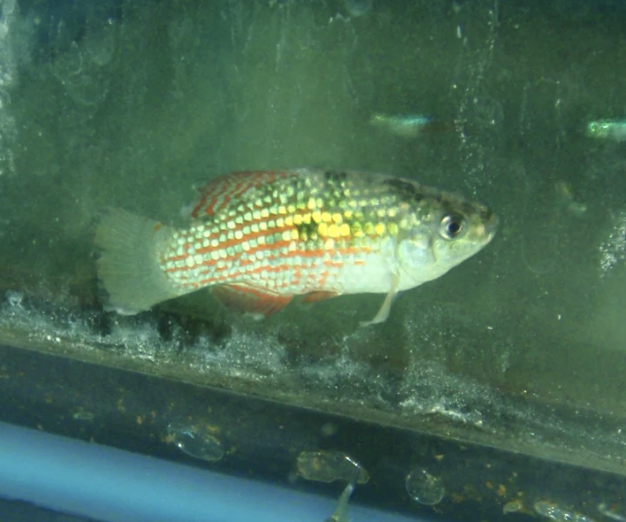Blue Daisy Ricefish
1. Aquarium Setup:
Ricefish are generally small, so a small aquarium is suitable. A 10 to 20-gallon tank is often sufficient.
Provide a well-filtered aquarium with gentle water movement.
Use a substrate like fine gravel or sand.
2. Water Parameters:
Ricefish prefer slightly acidic to neutral water conditions.
pH: 6.0-7.0
Temperature: 72-78°F (22-26°C)
3. Tank Decor:
Include live plants to provide hiding spots and mimic their natural environment.
Use driftwood, rocks, or other decorations to create hiding places.
4. Lighting:
Ricefish do not have specific lighting requirements, but a natural day-night cycle is beneficial.
5. Diet:
Ricefish are omnivores. Feed them a varied diet that includes high-quality flakes, pellets, and live or frozen foods like brine shrimp or daphnia.
6. Tank Mates:
Ricefish are peaceful, so choose tank mates that are not aggressive.
Small tetras, rasboras, or other peaceful community fish are usually good choices.
7. Breeding:
Ricefish are known for their interesting breeding behaviors.
Provide fine-leaved plants or a spawning mop for them to lay their eggs.
The fry are tiny and need to be fed appropriately sized foods like infusoria or commercially available fry food.
8. Water Quality:
Maintain good water quality by performing regular water changes.
Test water parameters regularly to ensure they are within the recommended range.
Always research the specific requirements of the exact species or variety you have, as different ricefish may have slightly different preferences. Additionally, it's recommended to stay updated with the latest information from reliable sources, such as aquarium forums, books, or articles, to ensure the best care for your specific fish.
1. Aquarium Setup:
Ricefish are generally small, so a small aquarium is suitable. A 10 to 20-gallon tank is often sufficient.
Provide a well-filtered aquarium with gentle water movement.
Use a substrate like fine gravel or sand.
2. Water Parameters:
Ricefish prefer slightly acidic to neutral water conditions.
pH: 6.0-7.0
Temperature: 72-78°F (22-26°C)
3. Tank Decor:
Include live plants to provide hiding spots and mimic their natural environment.
Use driftwood, rocks, or other decorations to create hiding places.
4. Lighting:
Ricefish do not have specific lighting requirements, but a natural day-night cycle is beneficial.
5. Diet:
Ricefish are omnivores. Feed them a varied diet that includes high-quality flakes, pellets, and live or frozen foods like brine shrimp or daphnia.
6. Tank Mates:
Ricefish are peaceful, so choose tank mates that are not aggressive.
Small tetras, rasboras, or other peaceful community fish are usually good choices.
7. Breeding:
Ricefish are known for their interesting breeding behaviors.
Provide fine-leaved plants or a spawning mop for them to lay their eggs.
The fry are tiny and need to be fed appropriately sized foods like infusoria or commercially available fry food.
8. Water Quality:
Maintain good water quality by performing regular water changes.
Test water parameters regularly to ensure they are within the recommended range.
Always research the specific requirements of the exact species or variety you have, as different ricefish may have slightly different preferences. Additionally, it's recommended to stay updated with the latest information from reliable sources, such as aquarium forums, books, or articles, to ensure the best care for your specific fish.
1. Aquarium Setup:
Ricefish are generally small, so a small aquarium is suitable. A 10 to 20-gallon tank is often sufficient.
Provide a well-filtered aquarium with gentle water movement.
Use a substrate like fine gravel or sand.
2. Water Parameters:
Ricefish prefer slightly acidic to neutral water conditions.
pH: 6.0-7.0
Temperature: 72-78°F (22-26°C)
3. Tank Decor:
Include live plants to provide hiding spots and mimic their natural environment.
Use driftwood, rocks, or other decorations to create hiding places.
4. Lighting:
Ricefish do not have specific lighting requirements, but a natural day-night cycle is beneficial.
5. Diet:
Ricefish are omnivores. Feed them a varied diet that includes high-quality flakes, pellets, and live or frozen foods like brine shrimp or daphnia.
6. Tank Mates:
Ricefish are peaceful, so choose tank mates that are not aggressive.
Small tetras, rasboras, or other peaceful community fish are usually good choices.
7. Breeding:
Ricefish are known for their interesting breeding behaviors.
Provide fine-leaved plants or a spawning mop for them to lay their eggs.
The fry are tiny and need to be fed appropriately sized foods like infusoria or commercially available fry food.
8. Water Quality:
Maintain good water quality by performing regular water changes.
Test water parameters regularly to ensure they are within the recommended range.
Always research the specific requirements of the exact species or variety you have, as different ricefish may have slightly different preferences. Additionally, it's recommended to stay updated with the latest information from reliable sources, such as aquarium forums, books, or articles, to ensure the best care for your specific fish.




